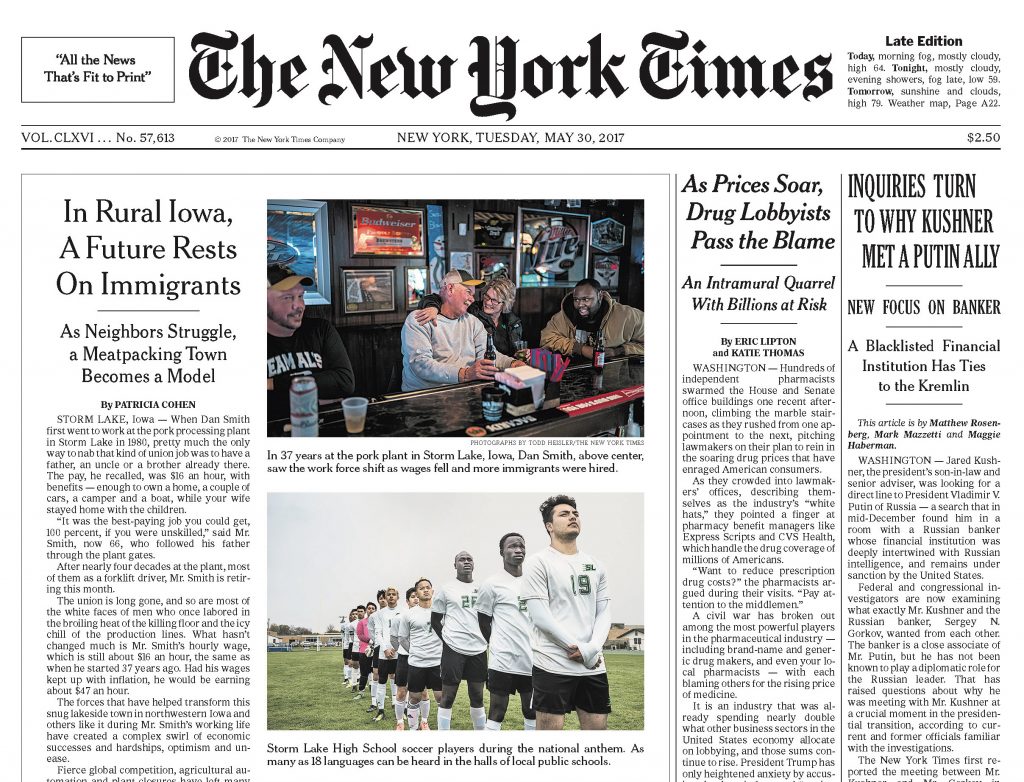On the front page of the May 30, 2017, New York Times, a headline summarized contemporary Storm Lake: “In Rural Iowa, A Future Rests On Immigrants.”
It’s a story known to many in Buena Vista County, an impressive and concise summary of the strengths and weaknesses of Storm Lake’s economy and community. We read this piece this week, which led to a conversation on the paradox of the town’s history. When Hygrade closed in 1981, and union jobs vanished, the city found itself all the more vulnerable to the vagaries of industrial forces. Enter IBP, which hired non-union workers and recruited heavily among Latino populations for less pay.

Looking at this moment now, decades later, it was perhaps the pivotal moment for the community in the twentieth century. But was it the apex or the nadir of Storm Lake’s story? Can one lament a deteriorating labor environment while simultaneously feeling inspired by the community?
We were fortunate to have the article’s author join us for a conversation by Zoom. Patricia Cohen covers the national economy for the Times, and her article prompted a wide-ranging conversation on immigration, the forces of capitalism, and generational change.
Students heard of her time in Storm Lake, and they also learned how a consummate professional (yet outsider) managed to capture, in relatively few words, the heart of the Storm Lake story. Her secret? “What I did for Storm Lake is what I would say any good reporter does for anything: … I come really prepared, and I do all the research that I can possibly do.” Yes!
It’s a good reminder as students embark upon their own research this semester. Students Anna Rottenborn, Adam Kimble, Michel Reising, and Nathaniel Hieber put various questions to Cohen: why were younger white generations more likely to move out of town, and children of recent immigrants more likely to return? Did she encounter any episodes of explicit racism? What were her impressions of Storm Lake?

Cohen explained how her experience writing the piece demonstrated that journalists, like historians, can’t always anticipate the results. That’s why she went to Iowa: to listen. She met with church and police leaders, and with locals of Latin American and Southeast Asian origins. She struck up conversations in markets. She chit-chatted over sips of joe at the Grand Central Coffee Station.
She had gone to town anticipating writing a profile on Storm Lake’s embrace of multiculturalism. But she was astonished by the economic past that had led to such a present. “I thought that was a really fascinating part of the story,” she said, “which was, in the popular belief, that immigrants came and undercut the jobs. But, in fact, it was the reverse that happened. The companies had essentially busted the unions and cut pay, and then nobody wanted those jobs, and so immigrants were willing to take them at a lower wage.”
Her published article’s first featured interviewee, Dan Smith, appeared on her radar during a conversation with Art Cullen. She recalled Cullen saying, “You know, you should call this guy because he’s been [at Tyson/IBP/Hygrade] for 40 years now, and I think he’s retiring next week.” Cohen then continued, “And so, you know, my journalistic spidey-sense just went like, ‘bing bing bing bing bing,’ like, that’s the perfect guy, the magic notebook you hope to have someone come across.”
A detail provided by Mr. Smith, in fact, stood out in students’ minds and represents much of Storm Lake’s economic history: he worked as a forklift driver for most of his career, and made the same wage ($16 per hour) the entire time. Were this adjusted for inflation, it would have been triple the amount in 2017.
It’s emblematic of economic changes—for the worse, one could say—that are responsible for Storm Lake’s development in the last 40 years. And yet, without this, the city wouldn’t be thriving, albeit imperfectly, with a growing multicultural community. The other stories that Cohen found wouldn’t have been possible: the example of Silvino Morelos’s “Valentina’s Meat Market,” or the success of Abel Saengchanpheng.

Is Storm Lake the realization of the American dream, born from economic vulnerabilities? A student, Joey Puckett, put this question to Cohen. What did she think? Was this a tale of disappointment or of hope?
“The first thing I would say to you is,” she said, ever the journalist, “what you guys think is actually more important. It’s what are you taking away from the story. But I would have to kind of say both [hope and disappointment]. It’s one of the reasons I like that story, and I think that it got the attention that it did because it captured so many things that were going on in terms what had happened to union jobs in this country, not only meatpacking plants but in manufacturing plants and elsewhere, all over. As globalization occurred and jobs were exported abroad and unions were broken.”
“On the other hand,” Cohen continued, “if you look at kind of what we generally call ‘the crisis of rural America,’ which is that demographic trend of communities getting smaller and smaller, and aging, and people not wanting to move there, and no industries, then Storm Lake is a success story in that it has managed, however fitfully and however bumpy and lumpy along the way, to create this thriving community which, unlike a lot of others, is growing.”

